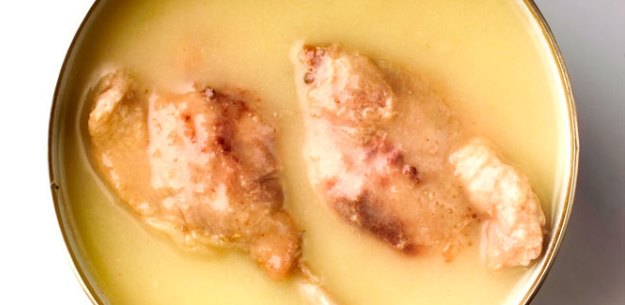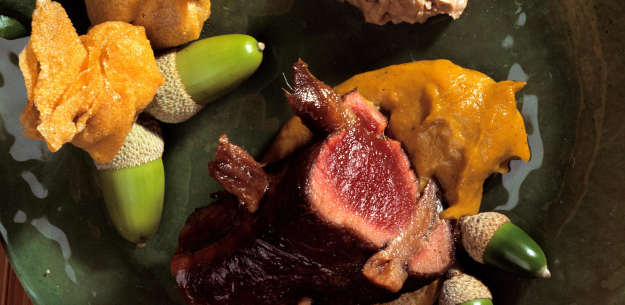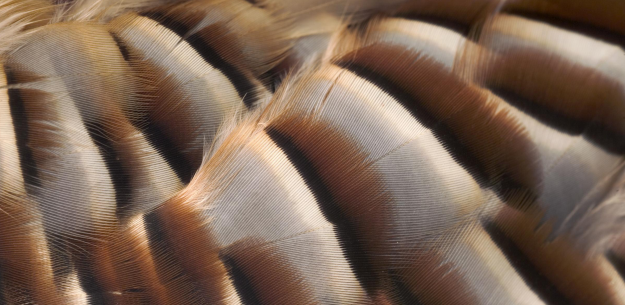.png.transform/rendition-xs/image_image%20(1).png)
Gourmet Game in a Can
From fields and mountains to factories and gourmet shops, game has become a product with an added value far beyond the simple, traditional hunter's reward. Large and small game, feathered and furred, wild and farmed, are being turned into conserves with long shelf lives, making gourmet flavors available for any occasion. Traditional dishes and well-seasoned pâtés are superb ideas for surprising your guests
It's a chilly winter's day with clouds hanging over the hilltops and a group of hunters are gathered over steaming cups of coffee to draw lots for the blinds they will occupy on the partridge hunt. Some of the hunters came from abroad and are staying at a nearby hunting lodge while others have driven down from Toledo (Castile-La Mancha) for the day bringing dogs, guns and gear with them.
The hunters move out in SUVs, bumping along rutted dirt tracks and fording a small stream. Leaving the vehicles, they trek cross-country to the first shooting site. Sun breaks through the cloud cover, glinting on flat outcroppings of shiny granite. Tramping boots release a powerful scent of wild thyme, marjoram and red lavender.
Each gun is flanked by a loader, who keeps the guns ready to fire, and a secretario, who spots and recovers the downed birds. The hunters and their entourages spread along the ridge taking up ten blinds. The beaters announce the start of the hunt with a blast on a conch shell. Suddenly, with a rush of wings, a covey of partridges loft skyward. The birds seem to scatter in the air, some soaring high, others dipping towards the next ridge. The first shots ring out, followed immediately by many more. The beaters continue, flushing birds before them. When the beaters reach the end of the line, they signal the end of the shoot with a horn and everyone scrambles to find the downed birds.
Cooking it Up
In bygone days, hunters brought their small game home. Some of it would be cooked fresh in time-honored dishes such as stewed partridge, hare with pasta and rabbit with beans. What couldn't be consumed freshly shot was preserved in a strong marinade of vinegar, wine, herbs and escabeche and sealed in earthenware pots or glass jars that would be further processed in boiling water to sterilize the contents. Game in escabeche could be kept for months. Nowadays, behind the hunters comes the poultryman. He buys the birds from the hunt's organizer and hauls them in refrigerated trucks to a processing plant. There they are cleaned, plucked and readied for sale to restaurants, specialty meat shops and small processing plants where the game is turned into gourmet quality conserves.
Large game, such as wild boar and red, roe and fallow deer, is less of a gastronomic tradition in Spain. Hunted for trophies in organized shoots called monterías, the animals, after a veterinary inspection, are butchered and the meat is shipped to Germany and France for sale. Only a few Spanish restaurants have become known for their venison and boar specialties. Now in Spain a whole new industry has developed for turning these meats into high-quality products, including canned preserved game, pâtés and sausages.
In the Factory
Taller Gastronómico in Los Yébenes, Toledo, is one such small company. It buys game from the poultrymen, from farms specialized in raising game birds and from licensed butchers registered to process deer and boar. In a small factory, partridge, quail, venison and boar are turned into delectable gourmet game products in tins: partridge pâté with Port, hare with truffles, boar with Armagnac, squab with brandy, stewed partridge and venison, quail escabeche, boar and venison sausages. "We start with raw materials that have been inspected by veterinarians and are fully documented" says Miguel Camacho, director of Taller Gastronómico. He maintains that small game, such as partridge used for canned conserves, comes from both wild and farm-raised birds. Large game, such as deer, derives entirely from hunts.
The partridge pâté produced by Taller Gastronómico and served at many restaurants in the Toledo area is smooth and unctuous. According to Miguel, it's made primarily with chopped partridge and partridge liver while duck and pork fat give it a creamy, mousse-like consistency. Restaurants serve it on toast with pickled red onions. It's such a delight!
Wine from Toledo and Game
The winemaker Carlos Falcó, Marqués de Griñón, serves game conserves at his wine estate, Dominio de Valdepusa, in the Toledo province. "We use these all the time because game is an essential part of the Montes de Toledo mountains regional gastronomy" he says. "Our estate is located in one of the best game regions in the world. These products go perfectly with all of our estate red wines. We use our Syrah and Svmma Varietalis (60% Syrah) with canned partridges and with cecina de ciervo, cured venison ham, and the more tannic wines (Cabernet Sauvignon-Petit Verdot-Emeritvs) for big game.
"Restaurateurs such Adolfo Muñoz from Restaurante Adolfo in Toledo use Spanish game conserves in his menus. "These are quality local products with a traditional flavor," says Adolfo. "We use them as a garnish, in emulsions to accompany certain dishes and also in rice dishes." Adolfo suggests entrees such as hare pâté with poached eggs, risotto with cheese and braised quail and partridge in escabeche with flame roasted vegetables.
Stewed partridge and partridge escabeche are very traditional dishes in Spain, but pâté is definitely a French import. One story of how it came to be part of Spanish gastronomy comes from the restaurant in Hotel La Perdiz in La Carolina (Jaén, Andalusia) on the main highway from Madrid to Andalusia. When the hotel opened in 1967, partridge in escabeche was the restaurant's signature dish, so during the shooting season its refrigerators were stocked with up to 5,000 partridge at one time. But what do you do with 5,000 partridge livers? The answer lay in the region's culinary heritage. The Sierra Morena mountains (north of Jaén province) was settled between 1767 and 1769 by French, Flemish, German, Italian and Swiss immigrants who used the liver to make pâté. Encased in a thin layer of beef fat and melted butter, partridge pâté became the restaurant's most popular appetizer.
Most canned pâtés incorporate about 20 percent of the selected game, which is combined with additional chicken and/or pork meat and sometimes liver, pork fat for a smooth, spreading consistency, milk, eggs, salt, pepper, herbs, other flavorings such as Port and nitrite and nitrate for conservation.
In the Restaurant
Andalusia has a long tradition of hunting and conserving game products and Restaurant Juanito, located in Baeza (Jaén), offers testimony. "We specialize in red-legged partridge dishes from this region" says Juan Luis Salcedo who, with his brother, now runs the restaurant opened by his parents 53 years ago. Their specialties include partridge in escabeche marinade, partridge stewed with beans and partridge pâté, all confected with extra virgin olive oil pressed on the family's estate.
However, no products are canned. "We buy wild partridge during the hunting season and farmed partridge the rest of the year", says Juan Luis. Not far from there is the natural park and hunting preserve in Cazorla, a rugged area rich in wildlife and game and Cárnicas Sierra de Cazorla in Chilluevar (Jaén) is also located in this vicinity. It's a modern food processing plant that grew out of a family business which produced traditional sausages and cured meat. "Our specialty now is pâté - partridge, venison and boar," says Antonio Jodar, whose brother Baltasar manages the company. "It's a select market, so there's less competition than in traditional chacinería (sausage making)."
Instead of making conventional pork sausages, now the company produces boar and venison chorizo. Some of it is marketed in jars and conserved in extra virgin olive oil for which Jaén's Cazorla region is famous. Products arrive already cleaned from packing plants in Toledo that are certified to process wild game, and authorized personnel monitor the preparation and sterilization of canned products to assure hygienic standards.
Because game preserves have a gourmet status, they make great presents. Quite a few small companies specialized in their production market special assortment packs, wrapping several different items in attractive cartons, wooden chests and boxes. They certainly do make a delightful and delicious gift!
Recipes of Carlos D. Cidón with game preserves
- Pickled partridge and Bierzo pepper salad with Lenteja Pardina de Tierra de Campos lentils
- Hare preserves with Judías de El Barco
- Tear-shaped pasta as a risotto with Boletus pinophilus, canned turtledove and smoked Dobro cheese
- Quail and orange soup, rhubarb sponge cake, Bierzo chestnut crumbs and duck liver
- Game pâté terrine with duck liver and mango cheese
It's a chilly winter's day with clouds hanging over the hilltops and a group of hunters are gathered over steaming cups of coffee to draw lots for the blinds they will occupy on the partridge hunt
Janet Mendel/©ICEX



- Image1
- Image2
- Image3

